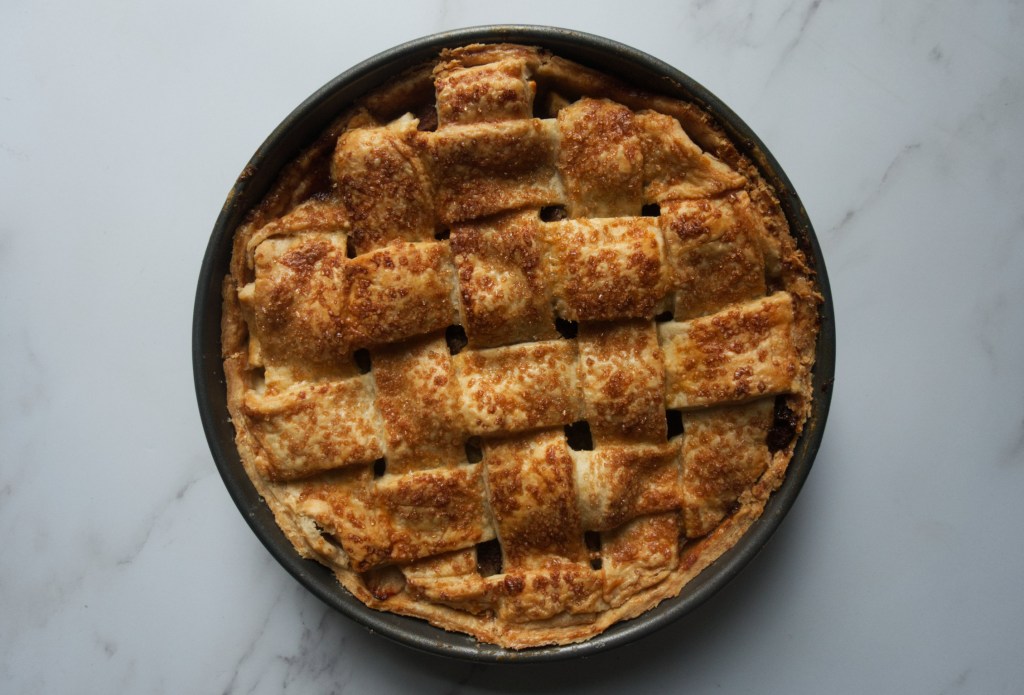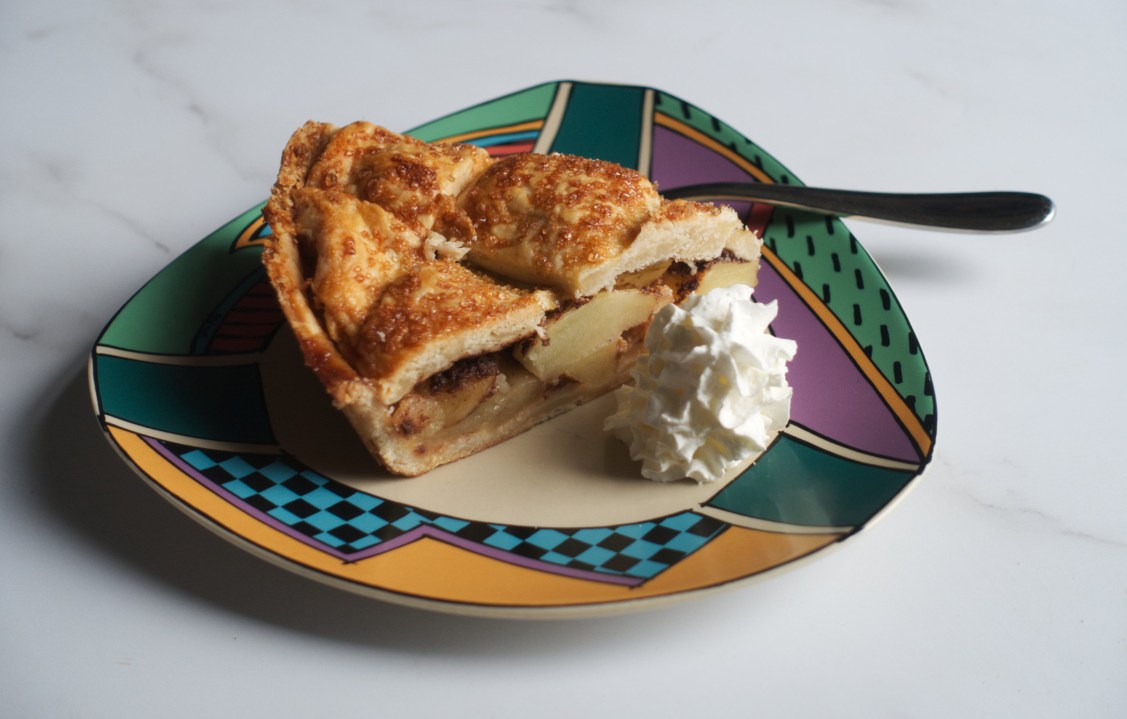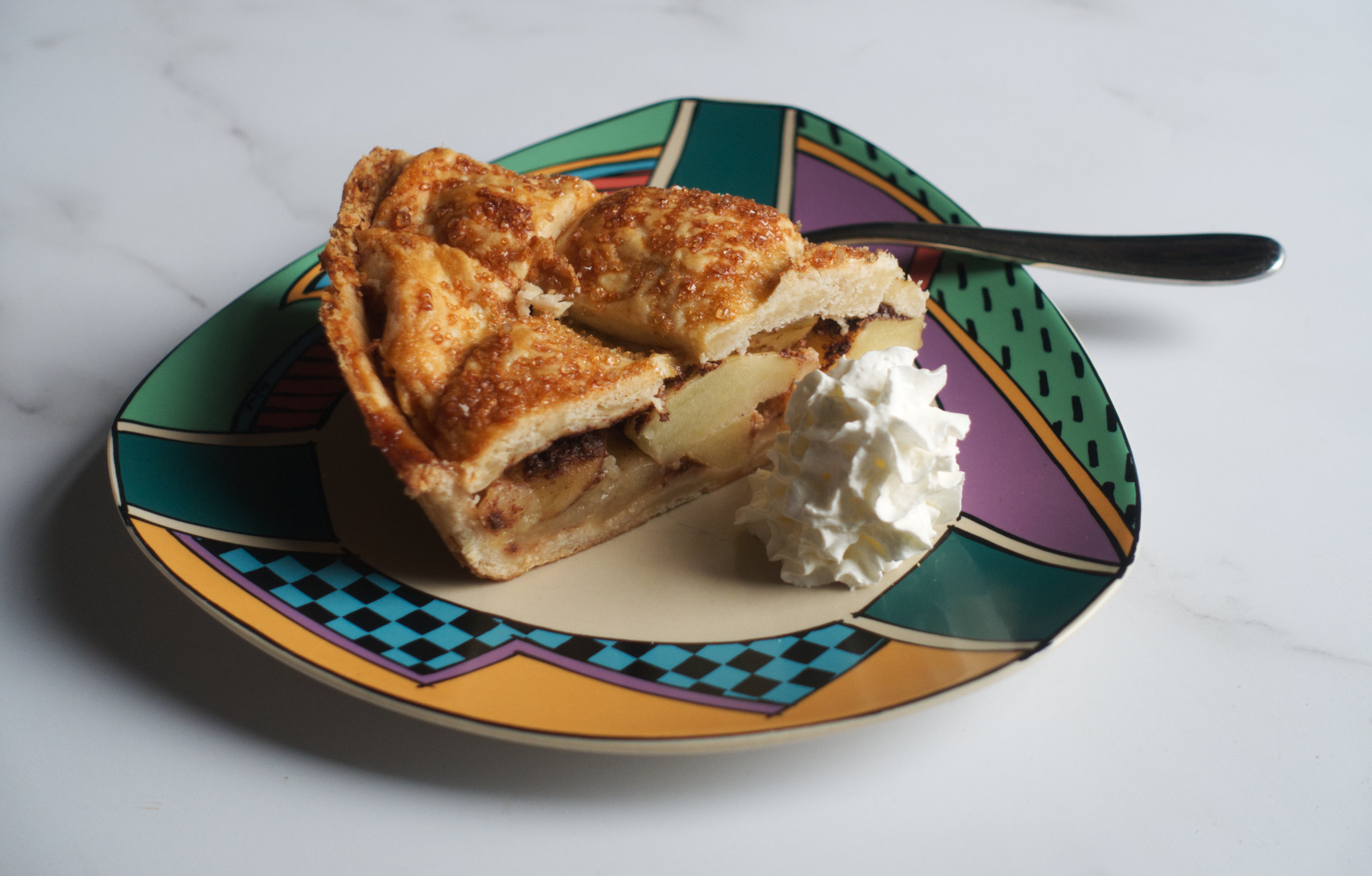Apple pies are synonymous with domesticity: both here and across the pond, the image of an apple pie, fresh from the oven, possibly cooling on a windowsill, speaks of family, and of homeliness. While they’re not difficult to make, they take time and care, and the making of one is an act of love. Perhaps that’s why they are such a simple and clear shorthand for comfort.
A proper apple pie is just as good hot as it is cold: it is both the perfect end to a Sunday lunch, submerged under custard, and the most delightful bowl of leftovers
A proper apple pie is just as good hot as it is cold: it is both the perfect end to a Sunday lunch, submerged under custard, or with a rapidly melting baseball of ice cream perched atop, and the most delightful bowl of leftovers, cold, and the good kind of stodgy, with squirty cream from a can. The Railway Children by E. Nesbit features just such an apple pie: when the children arrive at their new house in the country, it is night-time, and they don’t find the feast that had been left for them. The next morning, aided by daylight and rest, they happen upon it: alongside the roast beef, and cheese, bread and butter, there is an apple pie: so they have cold apple pie for ‘a wonderful breakfast’.
My apple pie sits somewhere between an American apple pie and an English apple pie. The apples are distinctly English: a mix of sharp eating apples and classic English Bramley apples or ‘cookers’; the eating apples will retain the shape as they soften and cook, whereas the Bramleys will break down into a sweet, saucy compote. The pastry, however, is all-American. Pie pastry is its own category: it should be flaky and crisp rather than short and crumbly, and this is achieved by stopping combining the butter with the dry ingredients when it is in little pea-sized lumps; you want to avoid the fine, sandy, breadcrumb texture that you seek when you make shortcrust pastry. This will also give your pie better structural integrity, which will make it easier to serve picture-perfect slices.

Although to this end, I will confess to a small cheat: I like to make the pie the day before, chill it down, and cut it into slices when cold before rewarming. For the full American pie effect, I like to lattice it, but that of course is just a flourish: a simple pastry lid, with or without crimped sides, is beautiful and elegant. Just remember to stab a couple of openings with your knife tip in the centre of the pie to release steam, and stop it overflowing.
I’ve borrowed a couple of brilliant pie tricks from the famous Brooklyn pie shop Four and Twenty, and their cookbook Four & Twenty Blackbirds Pie Book written by Emily and Melissa Elsen. For their apple pie, they let the apples sit in a mixture of sugar and lemon juice for 20 minutes before adding the apples to the pie: this ensures that the apples let go of a bit of their liquid before they’re baked, so that they don’t flood the pie and cause a soggy bottom. As an extra defence against this, I like to sprinkle two tablespoons of ground almonds across the bottom of the raw pie pastry.
And to their spice mix, Four and Twenty add angostura bitters. Using bitters is by no means essential – without them, you will still end up with a beautiful pie, and you should absolutely not be put off making it if you lack them – but their addition is a little bit of culinary genius. The bitters give the faintest back note of booze, and a smokiness that sits so well with the traditional spice accompaniments to apples: it pulls the pie together (and I bet none of your guests will be able to guess your secret ingredient).
Makes One 8-inch pie (serves 6-8 people)
Takes 2 hours, including chilling
Bakes 50 minutes
What you need
For the pastry
350g plain flour
1 teaspoon salt
1 tablespoon sugar
225g butter, cold and cubed
80ml water
30ml cider vinegar
1 ice cube
For the spice mix
50g light muscovado sugar
¼ teaspoon freshly ground nutmeg
¼ teaspoon mixed spice
½ teaspoon cinnamon
½ teaspoon salt
2 tablespoons ground almonds
5 dashes angostura bitters
For the apples
4 eating apples (peeled, cored and cut into chunks)
2 Bramley apples (peeled, cored and cut into chunks)
30ml lemon juice
2 tablespoons caster sugar
To top
1 egg yolk, beaten
2 tablespoons demerara sugar
1. First make the pastry. Rub the butter into the flour in a large bowl until the butter is in small pea-sized lumps. Combine the water, vinegar and ice, and sprinkle 2 tablespoons of the liquid over the mixture. Add the water a tablespoon at a time until you can bring the dough together into a ball: you may only need 3 or 4 tablespoons in total. Divide the dough equally in two; form into discs, clingfilm and refrigerate for at least an hour.
2. Once rested, remove from the fridge, and roll out one of the pieces of dough into a circle about 12 inches in diameter. Use this to line an 8-inch deep dish pie tin; I do this by rolling the pastry on to the rolling pin and then carefully rolling it out over the tin. Gently press and manipulate the pastry so that it’s flush against the tin. Trim any overhang pastry to about half an inch. Cover with clingfilm and refrigerate for at least 30 minutes.
3. If you’re making a simple pastry lid, roll the ball of dough into a circle just over 8 inches. If you’re making a lattice lid, roll the second ball of dough out to a circle about 14 inches in diameter. Using a pizza cutter or knife, remove an inch from both left and right side of the circle. Cut the remaining dough into inch-thick strips. Build a lattice on a piece of baking paper and refrigerate flat in the fridge for at least 30 minutes. Here is a good general guide on how to weave a pastry lattice.
4. Meanwhile, prep the apples (peel, core and cut into chunks) and then toss the apple chunks in the lemon juice and 2 tablespoons of caster sugar. Leave to sit for about 20 minutes.
5. To make your spice mix, using your fingers rub together the sugar, spices and bitters (if using) in a small bowl.
6. Now assemble the pie. Remove the pastry and tin from the fridge. Cut away any overhanging pastry from the tart tin, and sprinkle the base with the ground almonds. Drain the apples, and then stir the spice mix through them; pour the apples into the pastry-lined tin. Carefully transfer the pastry lid or lattice on top of the apples and shift the lattice strips so that they are tight and neat. Tuck any small overhang into the edge of the pie, and trim excess from the ends of the strips if you’re making a lattice. Refrigerate for 15 minutes and preheat the oven to 190°C.
7. Brush the lattice with a beaten egg and sprinkle with demerara sugar. Bake for 30 minutes. Reduce the heat to 175°C, cover with tin foil and bake for a further 20 minutes, until the pie is taut and golden. Serve hot or cold or, if you’re looking for picture perfect slices, chill down and slice, before reheating and serving.







Comments